Status and trends of polycyclic aromatic hydrocarbon concentrations in shellfish
Since 2012, polycyclic aromatic hydrocarbon concentrations in shellfish generally remain below the OSPAR threshold at which adverse effects occur in marine life. 88% of assessments in the Greater North Sea, and 92% in the Celtic Seas have met the associated UK target. Furthermore, concentrations are stable in all UK regions.
The findings for this indicator contribute to the assessment of the Marine Strategy Framework Directive (European Commission, 2008a) target, which the UK has set for contaminants (HM Government, 2012): “Concentrations of substances identified within relevant legislation and international obligations are below the concentrations at which adverse effects are likely to occur (e.g. are less than Environmental Quality Standards applied within the Water Framework Directive (European Commission, 2000) and Environmental Assessment Criteria (OSPAR Commission, 2009b) applied within OSPAR)”.
Background
UK target on polycyclic aromatic hydrocarbon concentrations in shellfish
In the UK Initial Assessment (HM Government, 2012), the key pressures associated with this indicator were riverine and direct inputs of polycyclic aromatic hydrocarbons arising from point and diffuse sources, atmospheric deposition and acute events that have entered marine sediments and can then accumulate in mussels (biota; Figure 1). These are still relevant.

Figure 1. Shellfish used in monitoring polycyclic aromatic hydrocarbons.
Measures taken to address the impacts
There is a robust UK legislative framework in place for controlling and reducing pollution from the main sources of contaminants (energy production, transport, urban and industrial uses, including appropriate consenting regimes and Water Framework Directive (European Commission, 2000) and River Basin Management Plans described in the UK Marine Strategy Part Three (HM Government, 2015).
Monitoring, assessment and regional co-operation
Areas that have been assessed
Status and trends assessments were conducted for the UK portion of the Greater North Sea and Celtic Seas Marine Strategy Framework Directive (European Commission, 2008a) sub-regions, and at the smaller scale of the 8 UK biogeographic marine regions set out in Charting Progress 2 (UKMMAS, 2010).
Monitoring and assessment methods
Risk-based monitoring and assessment of the status and trends of polycyclic aromatic hydrocarbon concentrations in shellfish was conducted within the annual UK Clean Seas Environmental Monitoring Programme using methods and principles set out the OSPAR Co-ordinated Environmental Monitoring Programme (OSPAR Commission, 2008 and 2014).
Assessment thresholds
Environmental Assessment Criteria (OSPAR Commission, 2009b) were derived by OSPAR for the assessment of polycyclic aromatic hydrocarbon concentrations in shellfish. Concentrations below the Environmental Assessment Criteria rarely cause any chronic effects in marine organisms.
OSPAR also has an aspirational ultimate objective to achieve the background concentrations which naturally occur in the marine environment and whilst not a UK Marine Strategy Framework Directive (European Commission, 2008a) target, the status and trend results were used to examine progress towards this objective.
Regional co-operation
The UK has played an important role in the development, monitoring and assessment of the OSPAR “Polycyclic aromatic hydrocarbons in sediment” common indicator (OSPAR Commission, 2009a). The UK results have been used in the OSPAR Intermediate Assessment (OSPAR Commission, 2017).
Further information
The UK monitors substances detailed in the OSPAR Co-ordinated Environmental Monitoring Programme in sediment, fish and shellfish and uses these data to assess if the targets set in the Marine Strategy Framework Directive (European Commission, 2008a) which cover polycyclic aromatic hydrocarbons have been achieved. The monitoring programme includes 9 parent polycyclic aromatic hydrocarbons, 7 polychlorinated biphenyls, polybrominated diphenyl ethers (9 congeners) and trace metals (Mercury, Cadmium and Lead) in sediment and biota and tributyltin in sediment. The OSPAR Co-ordinated Environmental Monitoring Programme is the monitoring under the OSPAR Joint Assessment and Monitoring Programme (OSPAR Commission, 2014) where the national contributions overlap and are co-ordinated through adherence to commonly agreed monitoring guidelines, quality assurance tools and assessment tools. Assessment of data collected under the Co-ordinated Environmental Monitoring Programme is prepared by the OSPAR Working Group on Monitoring and on Trends and Effects of Substances in the Marine Environment and is based upon data reported by Contracting Parties to the International Council for the Exploration of the Sea and held in their Environmental database. The OSPAR Strategy for Hazardous Substances has a strategic objective which is to ‘Move towards the cessation of discharges, emissions and losses of hazardous substances by 2020 with the ultimate aim of achieving concentrations in the marine environment of near background for naturally occurring substances and close to zero for man-made substances’.
The UK Clean Seas Environment Monitoring Programme is operated to ensure a uniform monitoring programme across the United Kingdom. The main focus of the programme is to meet the temporal trend monitoring requirements of the OSPAR Convention and in respect of compliance with European Directives such as the Water Framework Directive (European Commission, 2000). Contaminant and biological effects data is submitted to the UK Marine Environment Monitoring and Assessment National database and from there to the International Council for the Exploration of the Sea Environmental database.
For contaminants, the list of common indicators includes the OSPAR Co-ordinated Environmental Monitoring Programme determinands. Polycyclic aromatic hydrocarbons are of concern due to their persistence potential to bioaccumulate, and toxicity, and are therefore included on the OSPAR List of Chemicals for Priority Action and their analysis in both sediment and shellfish is required for the OSPAR Co-ordinated Environment Monitoring Programme. This assessment report focuses on polycyclic aromatic hydrocarbons in sediment.
Polycyclic aromatic hydrocarbons are hydrocarbons composed of two or more fused aromatic rings, encompassing both parent (non-alkylated) compounds and alkylated homologues. Although polycyclic aromatic hydrocarbons can be produced through natural processes, they also arise from anthropogenic sources. Incomplete combustion processes are a major source of polycyclic aromatic hydrocarbons, but they can also be of petrogenic origin (crude oils or refinery products). Those of petrogenic origin include mainly alkylated, 2- and 3-ring polycyclic aromatic hydrocarbons formed as a result of diagenetic processes, whereas pyrolytic sources are comprised mainly of the heavier, parent (non-alkylated) polycyclic aromatic hydrocarbons. Assessment of the polycyclic aromatic hydrocarbons profile, including concentration ratios such as the phenanthrene/anthracene or fluoranthenene/pyrene ratio can give an indication of source.
Polycyclic aromatic hydrocarbon properties will vary considerably depending on the number of rings. Low molecular weight polycyclic aromatic hydrocarbons can cause tainting of fish and shellfish and render them unfit for sale (Davis and others, 2002). Metabolites of some of the high molecular weight polycyclic aromatic hydrocarbons, such as benzo[a]pyrene, are potent animal and human carcinogens. Less is known about the toxicity of alkylated polycyclic aromatic hydrocarbons, although one study has demonstrated that they may have increased toxicity compared to the parent compound (Marvanova and others, 2008).
There are marked differences in the behaviour of polycyclic aromatic hydrocarbons in the aquatic environment between the low molecular weight compounds (such as naphthalene) and the high molecular weight compounds (such as benzo[ghi]perylene) as a consequence of their differing physico-chemical properties. The low molecular weight compounds are appreciably water soluble and can be bioaccumulated from the dissolved phase by transfer across gill surfaces, whereas the high molecular weight compounds are relatively insoluble and hydrophobic and can attach to both organic and inorganic particulates within the water column. Polycyclic aromatic hydrocarbons derived from combustion sources may be deposited to the sea already adsorbed to atmospheric particulates, such as soot particles.
Polycyclic aromatic hydrocarbons can enter the marine environment through atmospheric deposition, run-off, industrial discharges and as a result of oil spills. Sediment will act as a sink for polycyclic aromatic hydrocarbons in the marine environment. They are readily taken up by marine animals both across gill surfaces and from their diet (Baumard and others, 1999). Filter-feeding organisms such as bivalve molluscs can accumulate high concentrations of polycyclic aromatic hydrocarbons. Fish are exposed both via uptake across gill surfaces and from their diet, but do not generally accumulate high concentrations of polycyclic aromatic hydrocarbons as they possess an effective mixed-function oxygenase system which allows them to metabolise polycyclic aromatic hydrocarbons and to excrete them in bile (Stagg and others, 1995; Richardson and others, 2001). Other marine vertebrate and marine mammals also metabolise polycyclic aromatic hydrocarbons efficiently.
Assessment method
This 2016 assessment of data from the Clean Seas Environment Monitoring Programme describes the trends and status of contaminant concentrations at biota monitoring stations around the UK. Assessments are made for many time series, each of a single contaminant at a single monitoring station. This section describes how the results of the individual time series are synthesised to assess status and trends at the biogeographic regional level.
Nine polycyclic aromatic hydrocarbon compounds, for which assessment criteria were available, were assessed for status and trends (Table 1). The regional assessment only considers coastal and offshore stations and excludes estuarine stations. The results are therefore based on the monitoring data collected within the waters assessed under the Marine Strategy Framework Directive (European Commission, 2008a) and are used as part of the UK’s assessment of Contaminants.
Table 1. Background Assessment Concentrations (BAC) (OSPAR Commission, 2009b) and Effects Range-Low values (ER-L) available for the assessment of polycyclic aromatic hydrocarbons in mussels. All concentrations are expressed as μg per kg dry weight (dw). Background Assessment Concentrations and Environmental Assessment Criteria are converted to other bases (wet, dry or lipid weight) using species-specific conversion factors. Polycyclic aromatic hydrocarbons are not routinely monitored in fish, so no Background Assessment Concentrations and Environmental Assessment Criteria for fish have been derived.
|
Polycyclic aromatic hydrocarbon |
Abbreviation |
BAC (μg kg-1 dw) |
EAC (μg kg-1 dw) |
|
Phenanthrene |
PA |
11.0 |
1700 |
|
Anthracene |
ANT |
290 |
|
|
Fluoranthene |
FLU |
12.2 |
110 |
|
Pyrene |
PYR |
9.0 |
100 |
|
Benz[a]anthracene |
BAA |
2.5 |
80 |
|
Chrysene /Triphenylene |
CHR |
8.1 |
|
|
Benzo[a]pyrene |
BAP |
1.4 |
600 |
|
Benzo[ghi]perylene |
BGHIP |
2.5 |
110 |
|
Indeno[123-cd]pyrene |
ICDP |
2.4 |
Assessment scales
All the monitoring stations where there are suitable data are shown in Figure 2, with the purple circles showing stations where there is trend information for at least one polycyclic aromatic hydrocarbon, and the blue circles showing stations where there is only status information. The areas delineated by the thinner black lines are the biogeographic regions and those delineated by the thicker black lines are the Marine Strategy Framework Directive (European Commission, 2008a) sub-regions. The number of stations in each biogeographic region is given in Table 2.

Figure 2. Monitoring stations used to assess polycyclic aromatic hydrocarbon concentrations in shellfish. The purple circles are stations where there is a trend assessment for at least one polycyclic aromatic hydrocarbon, and the blue circles are stations where there are only status assessments.
Table 2. Number of stations within each biogeographic region. Only UK regions with at least 3 stations with a reasonable geographic spread were included in the regional assessment of status and trends.
|
Region |
UK biogeographic regions |
Trends |
Status |
|
Greater North Sea |
Northern North Sea |
12 |
14 |
|
Southern North Sea |
1 |
2 |
|
|
East Channel |
0 |
0 |
|
|
Celtic Seas |
Scottish Continental Shelf |
7 |
8 |
|
Minches and West Scotland |
10 |
15 |
|
|
Irish Sea |
13 |
16 |
|
|
West Channel and Celtic Sea |
0 |
0 |
|
|
Atlantic North west Approaches |
0 |
0 |
Concentrations of polycyclic aromatic hydrocarbons in shellfish
An individual time series of polycyclic aromatic hydrocarbon concentrations was assessed for status if:
- there is at least one year with data in the period 2010 to 2015
- there are at least 3 years of data over the whole time-series
- a parametric model can be fitted to the data and used to estimate the mean concentration in the final monitoring year (or, occasionally, if a non-parametric test of status is applied).
The time series was also assessed for trends if, in addition:
- there are at least 5 years of data over the whole time-series
- a parametric model can be fitted to the data and used to estimate the trend in mean concentrations.
Information on how the individual time series are assessed for status and trends is available from the British Oceanographic Data Centre.
For the regional assessment, the results from the individual time series are combined and a summary measure of status or trend is obtained from each time series. These are then modelled, using a linear mixed model, to estimate the mean status, or the mean trend in each biogeographic region. Only biogeographic regions with at least 3 monitoring stations with good geographic spread are considered in the regional assessment. Full details of the methodology is available from the British Oceanographic Data Centre.
The UK Marine Strategy Framework Directive (European Commission, 2008a) target for contaminants states that “Concentrations of substances identified within relevant legislation and international obligations are below the concentrations at which adverse effects are likely to occur (e.g. are less than Environmental Quality Standards applied within the Water Framework Directive (European Commission, 2000) and Environmental Assessment Criteria applied within OSPAR)”.
Two assessment criteria have been used by OSPAR to assess polycyclic aromatic hydrocarbon concentrations in biota (OSPAR Commission, 2008 and 2009b):
- Background Assessment Concentrations were developed by OSPAR for testing whether concentrations are near background levels. Mean concentrations significantly below the Background Assessment Concentration are said to be near background.
- Environmental Assessment Criteria for polycyclic aromatic hydrocarbons in sediment were not recommended for use in environmental assessments. Therefore, the Effects Range-Low values are used by OSPAR for the assessment of polycyclic aromatic hydrocarbon in sediment. Effects Range-Low values were developed by the United States Environmental Protection Agency for assessing the ecological significance of sediment concentrations. Concentrations below the Effects Range-Low rarely cause adverse effects in marine organisms. Therefore, polycyclic aromatic hydrocarbon concentrations in sediment should be below the Effects Range-Low values for Good Environmental Status to be achieved.
Results
Findings in the 2012 UK Initial Assessment
A number of exceedances of the Environmental Assessment Criteria (OSPAR Commission, 2009b) occurred. These were local in nature and close to the sources, particularly in industrialised estuaries and coasts (HM Government, 2012).
Latest findings
Polycyclic aromatic hydrocarbon concentrations are measured in shellfish (blue mussel) samples taken annually (or every few years) from UK coastal monitoring stations sampled as part of the Clean Seas Environment Monitoring Programme (Figure 2). Of the 178 time-series analysed for a trend assessment in the Celtic Seas and Greater North Sea, 13 showed a significant upward trend while 11 showed a significant downward trend. Of the 288 time-series analysed for the status assessment, 26 were above the Environmental Assessment Criteria.
Status assessment
12% of assessments in the Greater North Sea and 8% in the Celtic Seas exceeded the Environmental Assessment Criteria. Only 4 of the 8 UK biogeographic regions had a sufficient number of stations to undertake a regional status assessment, one in the Greater North Sea (Northern North Sea) and 3 in the Celtic Seas. More data is available for polycyclic aromatic hydrocarbons in shellfish, but this data was from estuarine stations and therefore excluded from the assessment. Average regional polycyclic aromatic hydrocarbon concentrations in mussels were below Environmental Assessment Criteria for all polycyclic aromatic hydrocarbon compounds. Therefore, concentrations are acceptable in the 4 UK regions assessed, and unlikely to cause any adverse effects (Figure 3). Similar to the sediment assessments, polycyclic aromatic hydrocarbon concentrations were lowest in the Minches and West Scotland region, however all were above background.

Figure 3. Map showing the overall regional status and trend assessment for polycyclic aromatic hydrocarbon in shellfish. Areas coloured green were below the Environmental Assessment Criteria. Darker grey areas had some data, but insufficient data for a regional assessment. The arrows represent the trend. A horizontal arrow indicates that there are no trends.
Trend assessment
Trends in polycyclic aromatic hydrocarbon concentrations in shellfish were assessed in 4 of the UK biogeographic regions (Figure 3). Concentrations were stable in all 4 regions.
Further information
The Environmental Assessment Criteria (OSPAR Commission, 2009b) was exceeded in 12% of assessments in the Greater North Sea and 8% in the Celtic Seas. Mean regional polycyclic aromatic hydrocarbon concentrations relative to the Environmental Assessment Criteria for each region are shown in Figure 4. Concentrations were below the Environmental Assessment Criteria for all polycyclic aromatic hydrocarbons in all regions and therefore unlikely to result in any adverse effects (Figure 5).
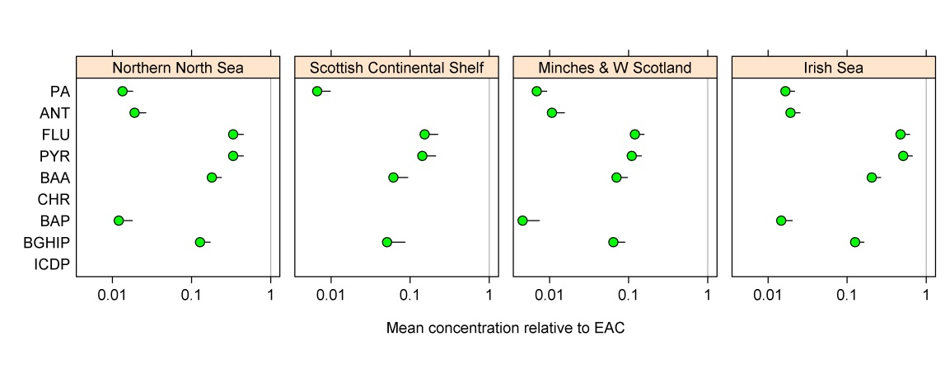
Figure 4. Status assessment: average polycyclic aromatic hydrocarbon concentration in shellfish in each biogeographic region, relative to Environmental Assessment Criteria (EAC) by compound (with 95% confidence limits). A value of 1 indicates the average concentration is equal to the Environmental Assessment Criteria. Green: statistically significantly below the Environmental Assessment Criteria. PA = phenanthrene, ANT = anthracene, FLU = fluoranthene, PYR = pyrene, BAA = benz[a]anthracene, CHR = chrysene (including triphenylene), BAP = benzo[a]pyrene, BGHIP = benzo[ghi]perylene, ICDP = indeno[123-cd]pyrene.
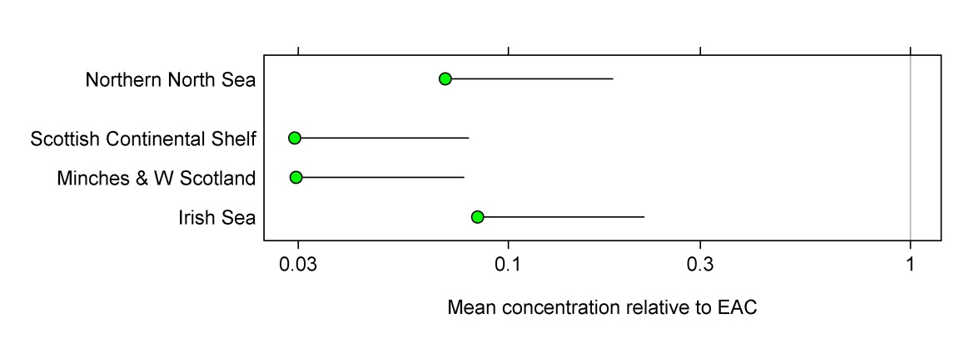
Figure 5. Status assessment. Average polycyclic aromatic hydrocarbon concentration in shellfish in each biogeographic region, relative to the Environmental Assessment Criteria (EAC) (with 95% confidence limits). A value of 1 indicates the average concentration is equal to the Environmental Assessment Criteria. Green: statistically significantly below the Environmental Assessment Criteria.
Mean regional polycyclic aromatic hydrocarbon concentrations relative to the Background Assessment Concentrations (OSPAR Commission, 2009b) are shown in Figure 6. Similar to the sediment polycyclic aromatic hydrocarbon concentrations were lowest in the Minches and West Scotland region. However, individual polycyclic aromatic hydrocarbon concentrations were above Background Assessment Concentrations in all regions. The overall assessment compared to the Background Assessment Concentration across all polycyclic aromatic hydrocarbon is shown in Figure 7. All regions were classed as being above background for polycyclic aromatic hydrocarbons in shellfish.
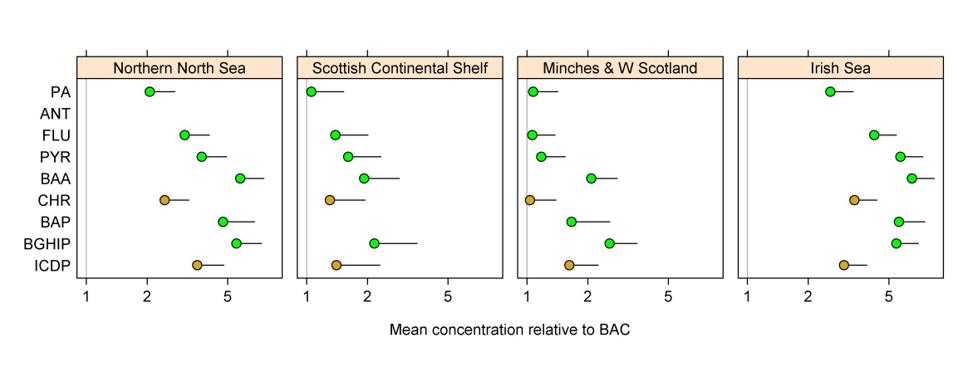
Figure 6. Status assessment; average polycyclic aromatic hydrocarbon concentration in shellfish in each biogeographic region, relative to the Background Assessment Concentration (BAC) by compound (with 95% confidence limits). A value of 1 indicates the average concentration is equal to the Background Assessment Concentration. Green: not significantly below the Background Assessment Concentration (but below the Environmental Assessment Criteria); orange: not significantly below the Background Assessment Concentration (and no Environmental Assessment Criteria). PA = phenanthrene, ANT = anthracene, FLU = fluoranthene, PYR = pyrene, BAA = benz[a]anthracene, CHR = chrysene (including triphenylene), BAP = benzo[a]pyrene, BGHIP = benzo[ghi]perylene, ICDP = indeno[123-cd]pyrene.
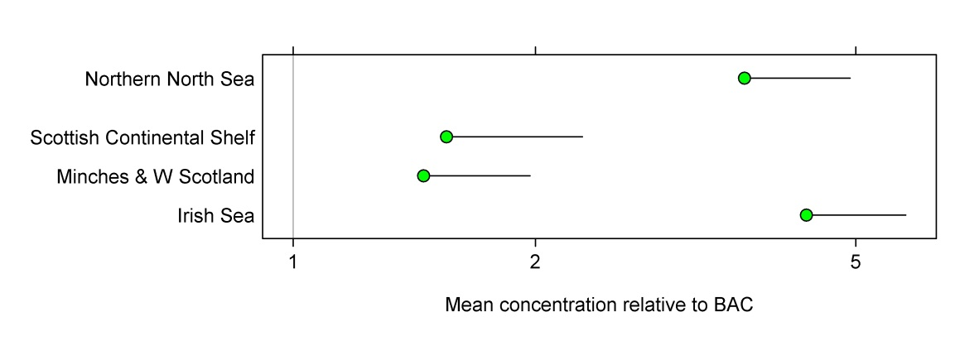
Figure 7. Status assessment; average polycyclic aromatic hydrocarbon concentration in shellfish in each biogeographic region, relative to the Background Assessment Concentration (BAC) (with 95% confidence limits). A value of 1 indicates the average concentration is equal to the Background Assessment Concentration. Green: not significantly below the Background Assessment Concentration (but below the Environmental Assessment Criteria).
Trends in polycyclic aromatic hydrocarbon concentrations were assessed in UK regions where there were at least 5 years of data, each containing at least one measurement above the detection limit. Four of the UK regions had sufficient data to be assessed for trends. The percentage yearly change for each polycyclic aromatic hydrocarbon in each region is shown in Figure 8. Overall polycyclic aromatic hydrocarbon concentrations in shellfish were stable and there were no significant trends in individual concentrations in any of the 4 regions assessed. Average percentage yearly changes were negative in Minches and West Scotland, with an average percentage annual decrease of 5.25%. This contrasts with polycyclic aromatic hydrocarbons in sediment where average percentage yearly change was positive. Shellfish sites cover coastal areas only, whilst sediment is also sampled further offshore.
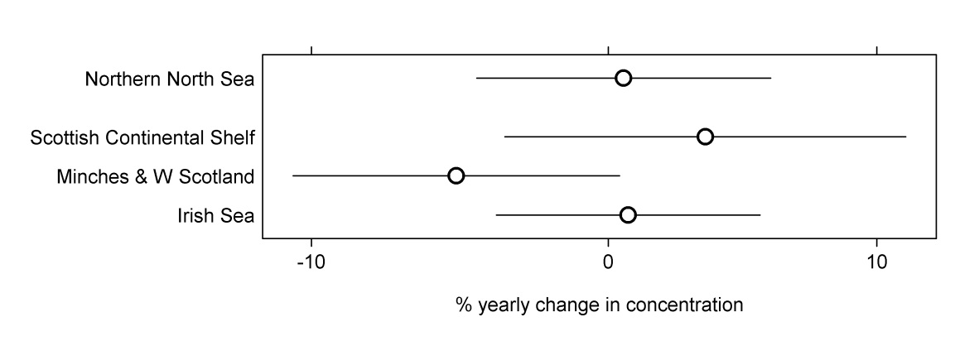
Figure 8. Trend assessment; average annual trends in polycyclic aromatic hydrocarbon concentrations in shellfish by biogeographic region (with 95% confidence limits). Circles indicate no significant change.
Conclusions
Since the UK Initial Assessment (HM Government, 2012), polycyclic aromatic hydrocarbon concentrations in shellfish have not changed overall. For both the Greater North Sea and Celtic Seas a very high percentage of stations meet the UK Good Environmental Status target for this indicator. No trends were observed. Polycyclic aromatic hydrocarbon concentrations in shellfish were stable in the Greater North Sea and Celtic Seas.
As polycyclic aromatic hydrocarbons can come from natural sources and from combustion processes that cannot always be fully controlled, they will always be found in the marine environment in some form. However, better use of emission control technology in combustion processes could improve the situation further.
All data on polycyclic aromatic hydrocarbons in biota are from coastal shellfish stations. As fish metabolise polycyclic aromatic hydrocarbons, open water fish stations are not part of the polycyclic aromatic hydrocarbon monitoring program. Monitoring of polycyclic aromatic hydrocarbon metabolites in fish bile could extend the biota monitoring program to include open waters.
Knowledge gaps
There is a lack of monitoring data in some of the UK biogeographic regions. Only 4 out of the 8 UK regions had sufficient data to be assessed. The Environmental Assessment Criteria (OSPAR Commission, 2009b) were used in the assessment of parent polycyclic aromatic hydrocarbons only, there are no assessment criteria for alkylated polycyclic aromatic hydrocarbons. There is a clear need for Environmental Assessment Criteria to be developed for alkylated polycyclic aromatic hydrocarbons in shellfish. There are no data from the open waters, as mussels are only found in coastal regions.
References
Baumard P, Budzinski H, Garrigues P, Narbonne JF, Burgeot T, Michel X, Belloccq J (1999) ‘Polycyclic aromatic hydrocarbon burden of mussels (Mytilius sp.) in different marine environments in relation with sediment and PAH contamination and bioavailability’ Marine Environment Research 47: 415 - 439 (viewed 3 December 2018)
Davis HK, Moffat, CF, Shepherd NJ (2002) ‘Experimental tainting of marine fish by three chemical dispersed petroleum products, with comparisons to the Braer oil spill’ Spill Science and Technology Bulletin 7: 257 – 278 (Viewed 3 December 2018)
European Commission (2000) ‘Directive 2000/60/EC of the European Parliament and of the Council establishing a framework for the Community action in the field of water policy’ Official Journal of the European Union L 327, 22.12.2000, pages 1–73 (viewed on 16 November 2018)
European Commission (2008a) ‘Directive 2008/56/EC of the European Parliament and of the Council of 17 June 2008 establishing a framework for community action in the field of marine environmental policy (Marine Strategy Framework Directive)’ Official Journal of the European Union L 164, 25.6.2008, pages 19-40 (viewed on 16 November 2018)
HM Government (2012) ‘Marine Strategy Part One: UK Initial Assessment and Good Environmental Status’ (viewed on 16 November 2018)
HM Government (2015) ‘Marine Strategy Part Three: UK Programme of Measures’ December 2015 (viewed on 16 November 2018)
Marvanova S, Vondracek J, Pencikova K, Trilecova L, Krcmar P, Topinka J, Novakova Z, Milcova A, Machala M (2008) ‘Toxic effects of methylated benz[a]anthracenes in liver cells’ Chemical Research in Toxicology 21: 503 – 512 (viewed 3 December 2018)
OSPAR Commission (2008) ‘CEMP Assessment Manual. Co-ordinated Environmental Monitoring Programme Assessment Manual for contaminants in sediment and biota’ OSPAR Publication 379/2008 ISBN 978-1-906840-20-4 (viewed on 03 December 2018)
OSPAR Commission (2009a) ‘Background Document on Polycyclic Aromatic Hydrocarbons’ OSPAR Publication 399/2009 ISBN 978-1-906840-39-6 (viewed 3 December 2018)
OSPAR Commission (2009b) ‘Background Document on CEMP Assessment Criteria for QSR 2010’ OSPAR Publication 461/2009. ISBN 978-1-907390-08-1 (viewed on 8 December 2018)
OSPAR Commission (2014), ‘OSPAR Joint Assessment and Monitoring Programme (JAMP) 2014 – 2021’ Ospar Agreement 2014-02 (viewed on 27 November 2018)
OSPAR Commission (2017) ‘Intermediate Assessment 2017’ (viewed on 16 November 2018)
Richardson DM, Davies IM, Moffat, CF, Pollard P, Stagg RM (2001) ‘Biliary PAH metabolites and EROD activity in flounder (Platichthys flesus) from a contaminated estuarine environment’ Journal of Environmental Monitoring, 3: 610-615
Stagg, RM, McIntosh AM, Mackie, P (1995) ‘The induction of hepatic mono-oxygenase activity in dab (Limanda limanda) in relation to environmental contamination with petroleum hydrocarbons in the North Sea’ Aquatic Toxicology, 33: 254-264 (viewed 3 December 2018)
UKMMAS (2010) 'Charting Progress 2: An assessment of the state of the UK seas' Published by Defra on behalf of the UK Marine Monitoring and Assessment Strategy community (viewed on 4 January 2019)
Acknowledgements
Assessment metadata
| Assessment Type | UK Marine Strategy Framework Directive Indicator Assessment |
|---|---|
D8 | |
D8.1 Concentration of Contaminants | |
Marine Strategy Part One | |
| Point of contact email | marinestrategy@defra.gov.uk |
| Metadata date | Monday, October 1, 2018 |
| Title | Status and trends of polycyclic aromatic hydrocarbons concentrations in shellfish |
| Resource abstract | Since 2012, polycyclic aromatic hydrocarbon concentrations are broadly similar and generally achieve the target described in the UK Marine Strategy Part One. |
| Linkage | In addition to links provided in ‘References’ section above:OSPAR Commission (2005) ‘2005 Assessment of data collected under the Co-ordinated Environmental Monitoring Programme (CEMP)’ Publication Number 235 (viewed on 10 January 2019) OSPAR Commission (2006) ‘2005/2006 CEMP Assessment: Trends and concentrations of selected hazardous substances in the marine environment’ Publication Number 288 (viewed on 10 January 2019) OSPAR Commission (2007) ‘2006/2007 CEMP Assessment: Trends and concentrations of selected hazardous substances in the marine environment’ Publication Number 330 (viewed on 10 January 2019) OSPAR Commission (2008) ‘CEMP Assessment Manual: Co-ordinated Environmental Monitoring Programme Assessment Manual for contaminants in sediment and biota’ Publication Number 379 (viewed on 10 January 2019) OSPAR Commission (2009) ‘CEMP assessment report: 2008/2009 Assessment of trends and concentrations of selected hazardous substances in sediments and biota’ Publication Number 390 (viewed on 10 January 2019) OSPAR Commission (2009) ‘Agreement on CEMP Assessment Criteria for the QSR 2010' Agreement 2009-2 (viewed on 10 January 2019) OSPAR Commission (2016) 'OSPAR Coordinated Environmental Monitoring Programme’ Agreement 2016-1 (viewed on 10 January 2019) |
| Conditions applying to access and use | © Crown copyright, licenced under the Open Government Licence (OGL). |
| Assessment Lineage | The 2016 assessment of the UK's Clean Seas Environment Monitoring Programme described the status and trends of contaminant concentrations and biological effects measurements in biota and sediment at monitoring stations in waters around the UK. Assessments were made for a large number of time series, typically each of a single contaminant in a single species (for biota) at a single monitoring station. The results of the individual time series at coastal and offshore stations were synthesised to assess status and trends at the biogeographic regional level and formed the basis of this indicator. Data were submitted to the MERMAN database from relevant Competent Monitoring Authorities. A series of templates were populated by submitting officers and submitted to the database which has in-built data restrictions and a data filter to ensure high quality, accurate data are submitted. The data filter has formulae in-built which use Accredited Quality Control information from known standards, limits, standard deviations and/or inter laboratory calibration exercises to calculate a score. Only data that passed a threshold agreed with the national advisory bodies were used for assessments. The data for 1999 - 2015 were extracted from MERMAN. Further data checks were made and records with obvious errors were deleted or corrected. The data were standardised to agreed units and bases. The data were grouped into time series of a single contaminant in a single species at a single monitoring station. Time series with no data for the period 2010 - 2015 were excluded. The individual time series were assessed for both trends and status. The methods behind the assessments and the individual time series results are available from the British Oceanographic Data Centre. The results of the individual time series at coastal and offshore stations were then synthesised to assess status and trends at the biogeographic regional level. The methods and results are available from the British Oceanographic Data Centre. |
| Dataset metadata | http://portal.oceannet.org/portal/start.php#details?tpc=012_Marine_Scotland_FishDAC_12111 |
| Dataset DOI | Marine Scotland. 2018. Contaminant and biological effect data to support MSFD Descriptor 8 1999-2015 by CSEMP Region. DOI: 10.7489/12111-1 |
The Metadata are “data about the content, quality, condition, and other characteristics of data” (FGDC Content Standard for Digital Geospatial Metadata Workbook, Ver 2.0, May 1, 2000).
Metadata definitions
Assessment Lineage - description of data sets and method used to obtain the results of the assessment
Dataset – The datasets included in the assessment should be accessible, and reflect the exact copies or versions of the data used in the assessment. This means that if extracts from existing data were modified, filtered, or otherwise altered, then the modified data should be separately accessible, and described by metadata (acknowledging the originators of the raw data).
Dataset metadata – information on the data sources and characteristics of data sets used in the assessment (MEDIN and INSPIRE compliance).
Digital Object Identifier (DOI) – a persistent identifier to provide a link to a dataset (or other resource) on digital networks. Please note that persistent identifiers can be created/minted, even if a dataset is not directly available online.
Indicator assessment metadata – data and information about the content, quality, condition, and other characteristics of an indicator assessment.
MEDIN discovery metadata - a list of standardized information that accompanies a marine dataset and allows other people to find out what the dataset contains, where it was collected and how they can get hold of it.
Recommended reference for this indicator assessment
Lynda Webster1 and Rob Fryer1 2018. Status and trends of polycyclic aromatic hydrocarbons concentrations in shellfish. UK Marine Online Assessment Tool, available at: https://moat.cefas.co.uk/pressures-from-human-activities/contaminants/pahs-in-biota/
1Marine Scotland
